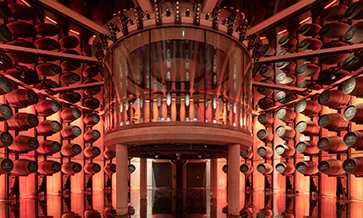Japanese whiskey has gained popularity in India and other countries around the world. It is considered one of the five major whiskies in the world, along with Scotch, Irish, American and Canadian.
According to the definition being considered by the Tokyo Whiskey Spirits Competition, Japanese whiskey is defined as whiskey produced in Japanese distilleries by saccharification (the process of using grain as raw material and enzymes to produce sugar), fermentation (using yeast), and maturation (in wooden casks or containers over a period of at least 2 years) in Japan.
This country produces single malt (whiskey made exclusively from barley malt and produced in a single distillery), grain whiskey (made from grains other than barley malt) and blended whiskey.
Single malt is mainly made from two-row barley, while grain whiskey is made from maize (corn).
In the 21st century, Japanese whiskey has won a succession of top awards at international competitions. In 2020, at the World Whiskey Awards, Japanese whiskies won the highest award for all the three types mentioned above.
Japanese Vs Scotch
Japanese whiskey was first produced at a brewery founded in 1923 by Shinjiro Torii. Masataka Taketsuru, who was invited to the brewery by Torii, then introduced Scottish methods to create whiskey. Therefore, it shares some similarities with Scotch whisky.
Incidentally, Shinjiro Torii founded what is now the Suntory brand, famous for Hibiki and Yamazaki. Taketsuru later established his own company, Nikka Whiskey.
Is spite of the similarity to Scotch, Japanese whiskey is more delicate than the other four kinds of whiskies. This is mainly because Japan has a climate with a range of seasons: hot, humid summers and cold, dry winters in many regions. The brewing methods are adapted to the seasons and climate.
Secondly, the water used has less organic constituent than in the other four major whiskey-producing regions of the world.
Furthermore, it differs from Scotch in that each brewery has its own individual character. This is because there was no custom of free exchange of casks with other companies or trading of casks.
Hence each company had to produce a variety of different raw materials. Furthermore, since Japan is spread over a long span from north to south and east to west, the climate varies from region to region.
I would now like to introduce the companies that produce Japanese whiskey. Suntory, founded by Shinjiro Torii; Nikka Whiskey, founded independently by Masataka Taketsuru; and Kirin are some of the major companies that produce whiskies.
Suntory saga
Suntory owns Yamazaki Distillery in Osaka Prefecture, Hakushu Distillery in Yamanashi Prefecture and Chita Distillery in Aichi Prefecture. The Yamazaki distillery benefits from a humid climate, proximity to water from a famous river, and proximity to Osaka, which is a major consumer.
It is one of the few distilleries in the world to use wooden and stainless steel casks to produce around 100 different types of malt whiskies in its original form.
Being Japan’s first whiskey distillery, the most famous whisky made here is the well-known malt whiskey, Yamazaki. It is a unique whiskey matured in wine barrels and Mongolian oak barrels – most whiskies around the world are brewed in Western oak barrels.
The specialty of the Hakushu distillery is its water (next to the brewery, there is a mineral water producing factory), which is used to produce a wide variety of malt and grain whiskies. Its famous brand is the single malt, Hakushu.
The Chita grain distillery is the largest in Japan and is located close to Nagoya, which is also a major consumer. A well-known brand produced at the distillery is the blended whiskey, Hibiki, and the grain whiskey, Chita.
Other whiskies that have been developed by Suntory abroad are Toki, brewed with a blend of carefully selected unblended whiskies from the globally acclaimed Yamazaki, Hakushu and Chita distilleries.
This overturns the conventional hierarchy between malt and grain. The texture is silky with a subtle sweet and spicy aftertaste.
Other stalwarts
Nikka Whiskey has distilleries in Yoichi (Hokkaido) and Miyagikyo (Miyagi Prefecture), where it produces the single malts Yoichi and Miyagikyo.
Kirin also has a distillery in Gotemba, at the foot of Mount Fuji in Shizuoka Prefecture, where it produces the blended whiskey Fuji-Sanroku.
In addition, craft whisky distilleries can be found from Hokkaido in the north to Okinawa in the south.
These include Venture Whiskey located in Chichibu City (Saitama Prefecture), which distils the internationally acclaimed Ichiro’s Malt. Hombu Shuz?, which originally brewed Sh?ch?, now makes the single malt Komagatake in southern Nagano Prefecture.
Sasanokawa Shuz?, a sake brewery located in K?riyama (Fukushima Prefecture) now makes Yamazakura. Each of these breweries make distinctive whiskies that makes the best use of the local climate and local ingredients and resources.
Whiskey distilleries, including those belonging to Suntory, Nikka, Kirin, Venture Whisky, Hombu Shuz? and Sasanokawa Shuz?, are all open to visitors.
According to one whiskey expert, when it comes to pairing whiskies with Indian cuisine, blended whiskies go well with yoghurt and complex spices.
Well-aged whiskey goes well with rich-flavored dishes; and single malts go well with dishes that have a crispy crust, such as samosas.
Japanese whiskey comes in a wide variety, including well-aged and young whiskies, single malt and blended whiskies. You can enjoy Indian food while drinking Japanese whiskey!













